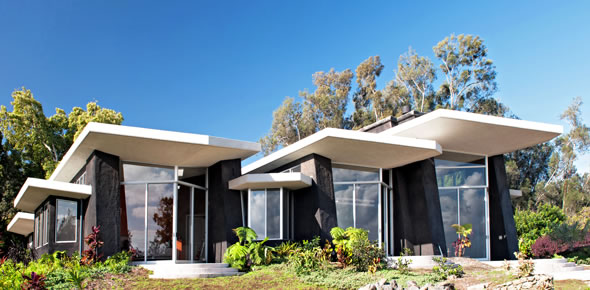Robert Mechielsen has learned several tricks of the net-zero trade in his nearly four decades of professional practice, but he isn’t one to guard secrets if they might help heal our natural environment. In fact, Mechielsen is eager to share the insights he’s gleaned over the years in hopes of seeing the ideals of carbon-neutral design hit their stride and become mainstream practices.
Mechielsen’s firm, Studio RMA, lately has been working in warm, subtropical places like Florida and Hawaii, an experience that has helped Mechielsen tease out the finer points of carbon-neutral design in such environments. Geothermal systems are not great fits for regions without true winters, places “where the cycle of hot and cool is not on a six-month cycle,” he says, “but is a day-and-night fluctuation.”
As he demonstrated in the recently completed Hi’ilani EcoHouse (Jan/Feb 2011) on the Big Island of Hawaii—the world’s first concrete, carbon-neutral residence in the US—the emergence of structural concrete insulated panels (SCIP) makes net-zero building a plausible reality in warm climates.
ICF’s Big Brother
Insulated concrete forms (ICFs) are increasingly common and are favored by environmentally minded designers for their high insulation value. Nothing makes a tight building envelope like ICFs. But in places where managing heat takes priority over managing cold, SCIPs make more sense—though they have their merits in temperate climates, too. “SCIP is like the new mighty brother of ICF,” Mechielsen says.
SCIPs are like ICF blocks in reverse. Instead of a rigid foam structure on the outside with concrete poured on the inside, SCIPs start out as five-inch-thick panels of EPS foam, which are then coated on either side with a 1.5-inch layer of concrete. The foam is contained within a wire mesh that also serves as a lath to support the stucco-like finish. The wire knits the concrete on both sides of the panel together, forming what Mechielsen refers to as “an integral monolithic concrete structure” once the cement hardens.
Several manufacturers now offer SCIPs in North America under trade names like Tridipanel and Metrock. With the structural integrity of poured concrete, they are code-compliant but use 60–70 percent less cement. Fire ratings on SCIPs are through the roof, and Mechielsen says there is no building he would feel safer in during a hurricane (while speaking from the Hi’ilani EcoHouse, where a Pacific hurricane was actually approaching).
Self-Energizing Structures
Putting the concrete on the outside of the foam core is the key that unlocks the door for Studio RMA’s warm-climate, net-zero homes. As with ICF, the foam insulates, and the concrete stores thermal energy. But the foam on SCIPs also buffers the interior wall from the heat that builds up in the exterior wall. Concrete block, which is currently the most common building material in the tropics, actually transfers the heat of the day through the wall, “so when you come home at five [o’clock], it’s hot as an oven,” Mechielsen says. SCIP structures, on the other hand, are “self-energizing” in that they create optimal interior temperatures passively rather than relying on artificially cooled air and the enormous quantity of energy it takes to create it.
SCIPs are as useful for roof construction as they are for walls. Studio RMA typically designs them in a butterfly formation to channel breezes into the home and rainwater into cisterns. The panels, four feet wide and made to any length desired by the designer, are lightweight and entirely modular. Construction is significantly faster than that of any other concrete-based approach or conventional wood framing, and they are also termite-resistant. Installation labor, therefore, is cheap, as are the panels themselves.
Mechielsen finds the use of SCIPs humanitarian, too. “Hot countries are typically not the most developed countries,” he says. Along with many others before him, he makes the link between air-conditioning and education. A student’s concentration diminishes when the temperature is 95 degrees with 95-percent humidity, as it often is in equatorial Africa, Latin America, and Southeast Asia. Families that can afford air-conditioning in these regions are typically the ones that send their kids to college, Mechielsen says.
As such countries slowly develop to so-called first-world standards and more of the population has the means to artificially cool their homes, the demand for coal-powered electricity rises. Mechielsen hopes that by offering a cost-effective, passively cooled construction method for the tropics, disadvantaged populations will feel empowered by the comfort of their dwellings and that literacy rates and college attendance will improve—without the associated rise in power production.
Net-Zero Calculus
Mechielsen, who has a background in structural engineering, is beyond thorough in his carbon production calculations and is quite conservative. He considers everything from Quest Construction Products’ nontoxic but high-performance HydroStop roofing system to the trucking of construction materials and the extensive travel involved for himself and the contractors he employs in remote locations like Hawaii.
The passively cooled Hi’ilani EcoHouse is completely independent from the electric grid, produces all of its own water from the rooftop-catchment system, and uses all-natural lime-plaster finishes throughout. The house is completely carbon neutral in its material and operation, but Studio RMA and the owners still chose to reforest three acres of grassland on the site in order to sequester the 100 tons of carbon dioxide that Mechielsen estimates was produced in the construction process.
According to his calculations, the emerging rainforest will reach the target in about 40 years, making the Hi’ilani EcoHouse, by one line of thinking, one of the first successes in carbon-positive building.

Unlike concrete block, which is currently the most common building material in the tropics, SCIPs do not transfer heat into a structure.

